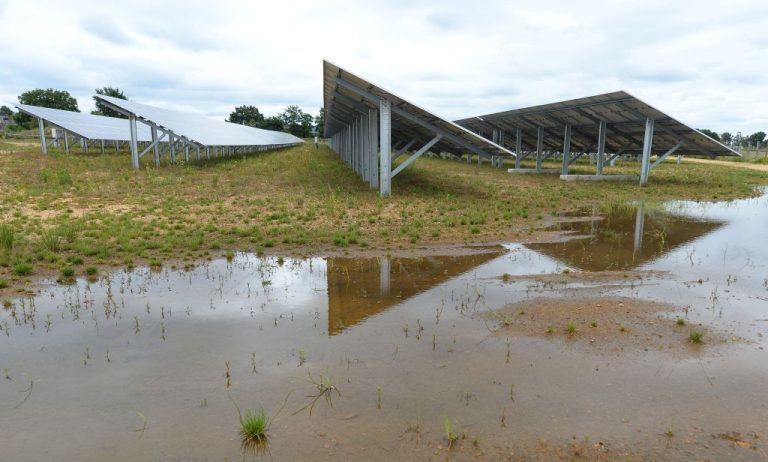As a monster heatwave is roasting most of Europe, although some countries are generating record amounts of power via solar panel arrays, the high temperatures are actually making the equipment significantly less efficient.
Germany set a record for most solar power generated in a day — 38,174 megawatts — on July 17, reported Bloomberg in July 18 reporting, a record which was anticipated to be eclipsed just two days later on July 19.
Although the statistic sounds auspicious for proprietors of renewable energy, temperatures across Germany, France, Greece, and England — upwards of 40 degrees celsius — are actually hampering wind turbines, meaning the additional power generated is simply filling a deficit.
MORE ON GLOBAL CRISIS
- Russia Signals European Natural Gas Deliveries Will Remain Cut at July 21 ‘Doomsday’
- Biden Admin Selling US Oil Reserves to China, Europe Amid Energy Crisis
- Worldwide Electronics Demand Slowing, South Korean Memory Chip Inventory Shows
- Is the US on the Cusp of a Housing Crash?
In conjunction with increased demand for residential and commercial cooling, the situation has actually led German spot electricity prices to also hit a three month record high of 397 Euros per megawatt ($403 USD approx).
For reference, according to data from the U.S. Bureau of Labor Statistics, the average price of electricity as of May in New York State is close to $250 per megawatt and $150 in the rest of the country.
Success
You are now signed up for our newsletter
Success
Check your email to complete sign up
In a July 18 article by EuroNews, they pointed out that the solar boon is “far from what the country’s solar panels could have achieved if the temperatures had been a little lower.”
They explain that while solar panels work by absorbing photons and producing an electrical current, “Most solar panels are tested at a temperature of 25 degrees Celsius, an ideal temperature at which this process occurs within solar panels under optimal circumstances.”
However, “The heat causes an excessive number of the panel’s electrons – the ones responsible for converting energy from the sun into electricity – to be excited, eventually reducing the panel’s generated voltage and its efficiency.”
According to the outlet, not only is the impact enough to diminish electrical generation by as much as 25 percent, but is a scaling problem, “For every degree Celsius more reported by a solar panel, its efficiency drops by 0.5 percentage points.”
Solar panel sales website EnergySage elucidated, “To understand how hot solar panels get, think about a car that’s been sitting in a hot parking lot on a summer day. The windows and frame will be hot to the touch, but there’s little danger of burns or fire.”
Not just a solar problem
Bloomberg added that the high temperatures have additional consequences in that river water that normally cools French nuclear plants is now too warm to fulfill its task.
Additionally, in a July 15 article, the outlet revealed that Germany’s coal-fired power plants are having difficulties receiving coal supplies as the level of the Rhine River has fallen so far that boats can no longer traverse the waterway.
Because of the low water levels and tight coal supplies in general, Sabrina Kernbichler, Global Commodity Insights analyst with S&P told Bloomberg that Germany will have no more than 65 percent of its coal capacity available over the next several months.
The situation has also impacted both German and Swiss oil imports and exports.
According to government data cited in the article, the water level had taken a shocking fall of almost 50 percent in just under two weeks, reaching levels not seen since 2007.
Far from green
Solar panels themselves are far from green. In July 14 reporting by the Los Angeles Times, the outlet explained that since 2006, LA residents and businesses have affixed solar panels to some 1.3 million rooftops under a $3.3 billion subsidy disbursement.
The problem, they state, is the lifecycle of the panels is only about 20 years, and now they’re heading to the landfill, and in large numbers.
Although the panels are often promoted as recyclable, San Vanderhoof, an expert and head of a local recycling center, told the Times that less than 1 in 10 panels were actually making their way back.
“The industry is supposed to be green…But in reality, it’s all about the money,” Vanderhoof stated.
Serasu Duran, an Assistant Professor at the University of Calgary’s Haskayne School of Business, told the Times, “While all the focus has been on building this renewable capacity, not much consideration has been put on the end of life of these technologies.”
The outlet explained one of the reasons, “Although 80% of a typical photovoltaic panel is made of recyclable materials, disassembling them and recovering the glass, silver and silicon is extremely difficult.”
And went into the details of the difficulty, “Recycling solar panels isn’t a simple process. Highly specialized equipment and workers are needed to separate the aluminum frame and junction box from the panel without shattering it into glass shards.”
The outlet explained that specialized furnaces are also needed, in addition to being hampered by often extremely stringent environmental regulations in different states because of the toxic substances contained within.
No more than $4 worth of materials can be recycled from a solar panel, they added.
“The National Renewable Energy Laboratory estimated that it costs roughly $20 to $30 to recycle a panel versus $1 to $2 to send it to a landfill,” the Times stated.

















